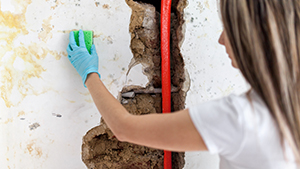
When the Humidity Starts to Rise and Temperatures Start to Warm, Common Household Mold Can Manifest
We’ve all seen mold at some point whether it be on bread or, more tragically, in your home. The types of mold vary, with some being fairly recognizable to the untrained eye. The following guide can help you differentiate between some of the more common molds.
Rundown of The Moldy Bunch
 Stachybotrys (“Black Mold”) – This is the most toxic mold of the bunch. Black mold is common and infamous for being a respiratory irritant. It is frequently found on wallpapers and furniture or in other areas of your home including your foundation or on corrugated cardboard (often in walls). Black mold requires excessive heat and humidity to grow successfully in an indoor environment, so this mold is especially relevant to South Louisiana. This type of house mold can cause breathing difficulties, coughing, and headaches. Lengthy exposure has even been found to contribute to lifelong conditions like depression or insomnia. Black mold needs to be cleared out of your home as quickly as possible by a trained professional like CLEAR Restoration.
Stachybotrys (“Black Mold”) – This is the most toxic mold of the bunch. Black mold is common and infamous for being a respiratory irritant. It is frequently found on wallpapers and furniture or in other areas of your home including your foundation or on corrugated cardboard (often in walls). Black mold requires excessive heat and humidity to grow successfully in an indoor environment, so this mold is especially relevant to South Louisiana. This type of house mold can cause breathing difficulties, coughing, and headaches. Lengthy exposure has even been found to contribute to lifelong conditions like depression or insomnia. Black mold needs to be cleared out of your home as quickly as possible by a trained professional like CLEAR Restoration.
Aspergillus – This mold often resembles a thin film of green dust. You’ve probably seen it start to grow on apples that have been left out a few days too long, but it can be more sinister when it grows on building materials. Sinusitis and a long list of respiratory complications are common symptoms of aspergillus exposure. Again, this mold needs to be treated as soon as possible by a professional.
Penicillium – Perhaps the most recognizable name of the molds, this fungus is used in the production of medicinal penicillin to ward off bacterial infections. However, when it’s found in your home, it can be harmful. It typically appears blue-green in color and is often found on wallpaper in especially damp areas. Penicillium spreads easily and can cause allergic reactions, so you definitely don’t want it in your home.
Diagnosing Your Mold
The side effects you may experience from mold exposure vary from mold to mold, but ultimately most molds look very similar in appearance to each other. Many different species of fungus can also take up residence in unseen areas of your home depending on humidity levels. If you experience any side effects but don’t see any mold on your walls, calling a professional is recommended as mold could be growing in your walls. The best way to determine your specific mold(s) is to have a mold test done in your home.

Don’t Try This at Home
It may be tempting to want to remove the mold yourself, but it’s recommended that you limit your exposure to it and instead call a professional like CLEAR Restoration. We’ll perform an inspection to determine if any potential molds are present. Should this be the case, we will recommend you contact a certified mold testing company to help diagnose your mold issue, so we can execute a flawless plan to remove the offending fungi. Following a thorough inspection and third-party testing, we get to work eliminating mold while keeping it contained in a localized area to prevent cross-contamination to unaffected areas of your home.
If you’ve started to notice some worrisome patches of fuzz growing in your home, call CLEAR Restoration today and breathe easy again in no time.



